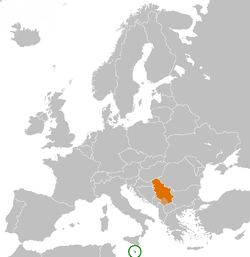 | |
Malta |
Serbia |
|---|---|
Maltese-Serbian relations are foreign relations between Malta and Serbia. Both countries established diplomatic relations in 1964. Malta is represented in Serbia through a non-resident ambassador based in Valletta (in the Foreign Ministry). Serbia has an Embassy Office in Valletta. Malta is an EU member and Serbia is an EU candidate.
History

Relations between Maltese and Serbians took place in early history in the framework of the relations between their masters, the British and the Ottoman empire.
In 1670, various Serbian Orthodox clergymen from the Eparchy of Marča were exiled and sentenced to life imprisonment in Malta after the eparchy (diocese) became a uniate Eastern Catholic vicariate and their refusal to enter into full communion with the Roman Catholic Church.
One of the first Maltese public figures of Serbian/Montenegrin descent was Giorgio Mitrovich (1795–1885), patriot and politician known for his role in the struggle for freedom of the press in Malta, whose homonym grandfather was a successful privateer originally from Venice-ruled Kotor who moved to Malta around 1770.
In 1918, a group of cadets and personnel of the Serbian army, on board of the SS Polynesien, was rescued to Malta and healed at Cottonera Hospital after the ship was sunk by a German torpedo.
During the Second World War, as during the first, Malta provided a rest and recuperation setting for British allies - in this case, Tito's Yugoslav partisans, led by Major Jerko Juricic, who set up a camp at Binġemma. While in Malta, the partisans (both male and female) could be trained by British experts in the use of both Ally as well as Axis weapons. At least one Yugoslav partisan died of his wounds in Malta, and was buried at the Military Cemetery.
In the late 1940s, Maltese emigrants left to Australia on board of the Yugoslav steamers SS Partizanka and SS Radnik.
Relations between newly independent Malta and socialist Yugoslavia during the Cold War were shaped by the Cold War context. Malta under socialist PM Dom Mintoff joined the Non-Aligned Movement, which had been launched by Yugoslav dictator Tito. Economic cooperation was marked by the construction of a small factory on the island with Yugoslav capitals. In the early 1980s, Yugoslavia donated a ship to Malta, upon the request of Mintoff.
During Mintoff's rule, marked by relations with Qaddafi's Libya, Yugoslavia was a rather warm ally of Malta, probably the primary one in Europe. Future foreign minister Michael Frendo wrote his graduate thesis in 1977 on "Workers' self-management: A new concept of the legal structure of the enterprise in Malta and Yugoslavia".
Agreements
Malta signed its 12th bilateral double taxation agreement with Serbia on 9 September 2009. Foreign Affairs Minister of Malta, Tonio Borg signed two agreements with Serbia during a two-day visit in 2010 about readmission of people residing without authorisation.
Diasporas
The Serbian community is one of the largest diasporas in Malta. Their number has steadily grown throughout the 2010s, and in 2017 - with 2,757 workers - Serbians were the second biggest non-EU foreign community on the islands after Libyans and just ahead of Filipinos, though the actual number is probably bigger. Serbian citizens in Malta work in the tourist industry and often follow a seasonal migration pattern. Crime rates, hooliganism and integration matters of the Serbian community has also come to the attention of Maltese society. Few Serbian-Maltese have come to the fore in Maltese society too.
See also
- Foreign relations of Malta
- Foreign relations of Serbia
- Malta–Yugoslavia relations
- Yugoslavia and the Non-Aligned Movement
- Malta and the Non-Aligned Movement
- Accession of Serbia to the European Union
References
- Direction of the Maltese representation in Serbia
- Serbian Ministry of Foreign Affairs: Malta
- Milutin Miltojević, Serbian Historiography of Union of Serbs in the 17th century, Niš University, p. 225
- Pics by Maltese nurse Mary Muscat may be seen here: http://agiusww1.com/page-57/
- Yugoslav partisans landing in Malta, Getty images, 1940
- pinterest - 1944 picture
- Yugoslav Partisans In Malta, Malta Independent, 2012
- Movie "Yugoslav Partisans in Malta"
- Report from the Department of Emigration for the year 1948-49.
- Tvrtko Jakovina, Yugoslavia on the International Scene: The Active Coexistence of Non-Aligned Yugoslavia, YUhistorija.com. See also JV, Predsedništvo SFRJ (Presidency of the SFRY), 25 November 1981, Presentation by Federal Secretary J. Vrhovec at the session of the Presidency of the SFRY, held on 25 November 1981 and devoted to the first item on the agenda
- University of Malta
- Malta-Serbia sign double taxation agreement
- Malta, Serbia sign agreements
- "Libyans top list of non-EU nationals in Malta".
- Micallef, Keith (2017-07-07). "Buġibba residents see red as rival Serbian supporters resort to vandalism". Times of Malta. Retrieved 2025-01-04.
- TVM
External links
- Direction of the Maltese representation in Serbia
- Serbian Ministry of Foreign Affairs about relations with Malta
| Africa |  | |
|---|---|---|
| Americas | ||
| Asia | ||
| Europe | ||
| Oceania | ||
| Former states | ||
| Multilateral |
| |
| Conferences | ||
| Diplomatic missions | ||
| Related topics | ||
| Africa |  | |
|---|---|---|
| Americas | ||
| Asia | ||
| Europe | ||
| Oceania | ||
| Multilateral relations | ||
| Disputes | ||
| Diplomacy | ||
| see also: Foreign relations of Yugoslavia & Serbia and Montenegro | ||